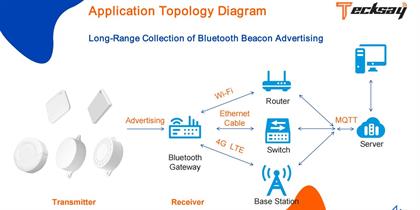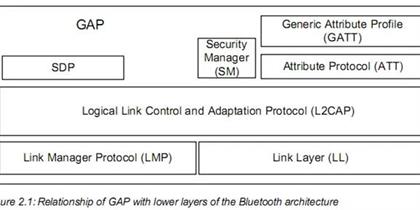
The Evolution of BLE Beacons: A Beacon of Progress in Bluetooth Technology
September 23, 2024

In the ever-expanding universe of wireless communication, Bluetooth technology has evolved from a simple wireless alternative to cables into a sophisticated enabler of IoT solutions. A significant milestone in this evolution is the emergence of Bluetooth Low Energy (BLE Beacon) beacons. These tiny devices have transformed the way we think about proximity, connectivity, and data exchange. This article explores the journey of BLE beacons, from their inception to the cutting-edge applications that are shaping the future of IoT.
The Birth of BLE Beacons
The story of BLE beacons begins with the introduction of BLE technology, which offered a new paradigm of wireless communication characterized by low power consumption and high efficiency. BLE beacons, initially developed as a part of Apple’s iBeacon in 2013, were designed to leverage the BLE protocol to broadcast signals to nearby devices, paving the way for a new era of proximity-based services.
The Evolution of BLE Technology
As BLE technology matured, so did the capabilities of beacons. The Bluetooth Special Interest Group (SIG), the governing body for Bluetooth standards, has played a crucial role in shaping the evolution of beacons. With each new version of Bluetooth, the range, data capacity, and security of beacons have improved, making them more versatile and reliable.
The Role of BLE Beacons in IoT
BLE beacons have become integral to IoT applications, serving as the eyes and ears of smart environments. They facilitate asset tracking, indoor navigation, customer engagement, and data collection. The ability of beacons to interact with smartphones and other BLE devices has opened up a world of possibilities for enhancing user experiences and optimizing operations.
Enhancements in Beacon Capabilities
Over time, the capabilities of BLE beacons have expanded. They now support more sophisticated data transmission, allowing for the exchange of more complex information. Beacons can now transmit not just basic identifiers but also contextual data, such as temperature, humidity, and even user preferences, enriching the interaction between devices and users.
The Impact of BLE 5 and Beyond
The introduction of Bluetooth 5 brought significant improvements to beacon technology. With its longer range, faster data transmission rates, and increased broadcasting capacity, Bluetooth 5 has made beacons more powerful and efficient. The upcoming Bluetooth 5.3 version promises even more enhancements, including improved precision and security, which will further bolster the role of beacons in IoT.
Security Advancements
As beacons became more prevalent, so did the need for robust security. BLE beacons now incorporate advanced encryption standards to protect data integrity and user privacy. Features like the Temporary Key Service (TKS) in Bluetooth 5.3 are designed to provide secure communication without the need for device pairing, ensuring that data exchange remains safe and private.
Integration with Other Technologies
BLE beacons are not operating in isolation. They are increasingly being integrated with other technologies, such as Wi-Fi, NFC, and cellular networks, to create hybrid solutions that offer greater flexibility and coverage. This integration is enabling more comprehensive IoT systems that can leverage the strengths of multiple communication protocols.
The Future of BLE Beacons
The future of BLE beacons is bright, with ongoing research and development aimed at enhancing their capabilities. We can expect to see beacons with even lower power consumption, more advanced data processing capabilities, and integration with AI and machine learning algorithms for predictive analytics and automated decision-making.
Conclusion
The evolution of BLE beacons is a testament to the dynamic nature of Bluetooth technology and its ability to adapt and innovate. From their humble beginnings as simple proximity markers, beacons have grown into powerful tools that are transforming the IoT landscape. As Bluetooth technology continues to advance, so too will the potential of beacons, promising a future where connectivity is seamless, intelligent, and ubiquitous.
Leave a Reply
Related Products
You Might Like Also

In the modern agricultural landscape, the integration of technology is not just a trend; it’s a necessity. As the global population continues to grow, the demand for food outpaces traditional farming methods. This is where the Internet of Things (IoT) steps in, with Bluetooth beacons playing a pivotal role in revolutionizing the way we approach agr Read More

In the intricate world of wireless communication, Bluetooth Low Energy beacons (BLE Beacons) play a pivotal role, particularly when it comes to connecting with gateways. These small yet powerful devices use the BLE protocol to transmit data, which can then be received and processed by a BLE gateway. The interaction between BLE beacons and gateways Read More

In the realm of Bluetooth Low Energy (BLE) technology, the link layer stands as the silent sentinel, weaving the fabric of connectivity between devices. It is the unsung hero, operating behind the scenes to ensure seamless and efficient data exchange. This article delves into the intricacies of the BLE link layer, exploring its role, functionalitie Read More

BLE Characteristics are the fundamental building blocks of GATT, representing the smallest unit of data that can be accessed, read, or written. They are the conduits through which devices exchange information, and their versatility is key to the dynamic nature of BLE technology. Read More

In the intricate world of Bluetooth Low Energy (BLE) communications, the Generic Attribute Profile (GATT) plays a pivotal role in defining the structure and methods for data exchange. Central to this are the processes of Notifications and Indications, which are the primary means by which GATT servers update clients about changes in attribute values Read More

Central to BLE’s functionality is the BLE Generic Attribute Profile (BLE GATT), which serves as the protocol’s backbone, enabling efficient and structured data communication between devices. This article aims to provide an in-depth exploration of GATT, its components, and its role in BLE technology. Read More











